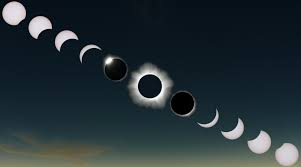It will almost eclipse my Honors Lecture...
Across North America on Monday, the moon will materialize and eat into the yellow orb of the sun, casting a shadow over a swath of Earth below, causing a total solar eclipse and reminding all in its path of our planet’s place in the cosmos.
Where the weather cooperates, millions of people will behold the disorienting, disquieting wonder of darkness in daytime. They will experience it on the beaches of Mexico and the plains of Texas; throughout the Midwest, New York State and New England; and across pockets of eastern Canada, from the steeples and spires of Montreal to the rugged coastline of Newfoundland... (continues)
Behind eclipse glasses or other safe means of viewing the phenomenon, they will watch the moon’s shadow grow until the light is extinguished.
In some places, it will be dim for as long as four and a half minutes, and in those moments eclipse viewers may gasp. They may shout. They may clap. They may even cry.
At this moment, it is dark in the South Pacific Ocean, where the eclipsed sun will first rise. As you prepare for this event to glide into your area, here’s what to know:
The partial eclipse will first make landfall in North America near Mazatlán, Mexico, around 12:51 p.m. Eastern. It will reach the edge of Texas, near Eagle Pass, around 1:10 p.m. Canada will catch its first glimpse at 3:12 p.m. The Canadian province of Newfoundland will be the last major piece of land to see the total eclipse, which will conclude there around 3:45 p.m.
The eclipse will carve a southwest-to-northeast path, sweeping through San Antonio at 2:33 p.m., Dallas at 2:40 p.m., Little Rock, Ark., at 2:51 p.m., Indianapolis at 3:05 p.m., Cleveland at 3:13 p.m. and Buffalo at 3:18 p.m.
While the eclipse is most impressive when viewed at totality, hundreds of millions of people may experience a partial eclipse. In Chicago, the sun will be about 94 percent obscured. In Boston, 93 percent. In New York (around 3:25 p.m. Eastern time) and Philadelphia, there will be a 90 percent eclipse.
Even the most devoted eclipse chasers know that they are at the mercy of the clouds. The New York Times’s weather data team has been tracking the forecast, which showed that nearly everyone along the path in the United States will have at least some chance of clouds obscuring their view. Danger of severe storms also compounded that concern in many parts of Texas. But there were some bright spots on the eclipse path, including Maine and other parts of New England, and optimism expressed for parts of Arkansas through Cleveland.
In the United States, about 32 million people live along the eclipse’s path, and countless more will be driving toward it (and, eventually, away from it), creating gridlock. Allow extra time, and lots of it.
It is never safe to look at the sun without protective eyewear. Throughout the partial stage of the eclipse, use eclipse glasses or try to construct a pinhole viewer to observe the shadow over the sun indirectly. It is safe to look at the fully eclipsed sun only for the duration of totality.
The next opportunity to see a total solar eclipse in the 48 contiguous U.S. states and Canada isn’t until 2044. To see a total eclipse before then, you’ll need to travel.





No comments:
Post a Comment